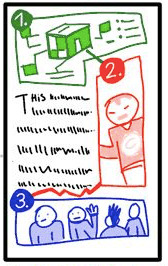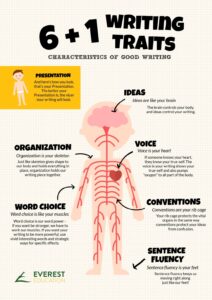Good writing has all of these traits
1. Ideas – good writing conveys a clear sense of purpose
Ideas are the heart of the message, the content of the piece, the main theme, together with the details that enrich and develop that theme. Ideas can be thoughts, argument, opinions, facts or stories.
Good writing has to:
– Be clear and focused
– Be fresh or original
– Have well-developed and supported ideas
Example: Once upon a time, there was a boy who didn’t want to grow up…
Question to ask your child:
– What is your message? What is the most important thing you want your audience to know?
– Is your message clear? How can you help your audience understand the main idea?
– Do you include specific, juicy details?
– What is usual or surprising about your message?
2. Organization – good writing reveals ideas within a logical order
Organization is the internal structure, the thread of central meaning, the logical and sometimes intriguing pattern of ideas within a piece of writing.
Good writing has to:
– Have sense of sequence: beginning, middle, and end
– Have a logical order
– Have smooth transitions
Examples: “If you want to form a band, the FIRST THING you have to do is find your musicians. SECOND, you need to choose a name. THIRD, you need to practice a lot…”
Questions to ask your child:
– Is the piece you wrote in order?
– Can the readers easily identify different parts of the piece?
– How does your writing start?
– How does your writing end?
3. Word choice – good writing uses the right word in the right place to convey just the right meaning.
Word choice is the use of rich, colorful, precise language that moves and enlightens the reader.
Good writing has to:
– Employ specific words, not general, vague ones
– Be descriptive and call on the five human senses
– Use strong action verbs
Examples: Instead of “I liked the song because it was pretty and stuff”, we can try: “The song’s lyrics and catchy verse really moved me”.
Questions to ask your child:
– Where do you use strong action verbs? What makes them effective?
– Do you use words that are appealing to the senses? Which words and phrases would the readers remember, and which senses do they appeal to?
– Is every word you use important? Will the meaning change if you cut out that word?
4. Sentence fluency – good writing is smooth and musical
Sentence fluency is the rhythm and flow of the language, the sound of word patterns, the way in which the writing plays to the ear — not just to the eye.
Good writing has to:
– Be easy to read aloud
– Have sentences that vary in structure (beginnings, lengths, types)
– Flow smoothly or rhythmically
Example: Instead of “I like Big Bang. I went to their concert. I have three of their T-shirts.”, try this: “My favorite band is Big Bang. Last summer, my best friend and I went to their concert when they came to Saigon. I love them so much, that when they came, I saved up two months of allowance so I could buy three souvenir T-shirts there!”
Questions to ask your child?
– Do sentences start differently?
– How does your writing sound when you read it aloud?
– Do you use complete sentences?
– Do you use rhythm, rhyme, alliteration and other “sound effects”? How does this improve your piece?
5. Voice – good writing increases reader engagement with intentional attitude and emotion.
Voice is the magic and the wit, along with the feeling and conviction of the individual writer coming out through the words.
Good writing has to:
– Establish a strong connection between the author and readers
– Reflect the writer’s unique personality
Example: Instead of “I liked Evan’s musical performance last night. He must spend a lot of time practicing”, you can try: “Evan rocked his piano solo last night. All those days and nights of drilling hunched over his keyboard have really paid off.”
Questions to ask yourself:
– Are you using an appropriate tone in this situation?
– Would the readers understand how you feel?
– How would the readers describe your personality?
6. Convention – good writing has no grammar mistakes
Convention refers to the mechanical correctness of the piece, including (but not limited to) spelling, paragraph structure, punctuation, grammar, and use of capitals.
Good writing has to:
– Be error free in spelling
– Put punctuations and capitalization in the right places
– Utilize correct grammar and mechanics
Example: Not this: “Imagine is very good its my favorite song by John Lennon”. Rewrite it as this: “’Imagine’ is very good. It’s my favorite song by John Lennon.”
Questions to ask yourself:
– Do you use a title?
– Do you capitalize the correct letters?
– Have you checked spelling?
>> Read more: 3 TED-Ed Videos Can Help Kids Master English Grammar With Fun
(+1). Presentation
Presentation combines both visual and textual elements. It is the way we exhibit or present our message on paper: balance of white space with visuals and text, graphics, neatness, handwriting, font selection, borders, and overall appearance.
Good writing has to:
– Be visually appealing in handwriting (or font selection)
– Have flowing text and spacial layouts (if not an academic essay)
– Be easy to read
Example:
Not this but this


Questions to ask your child:















